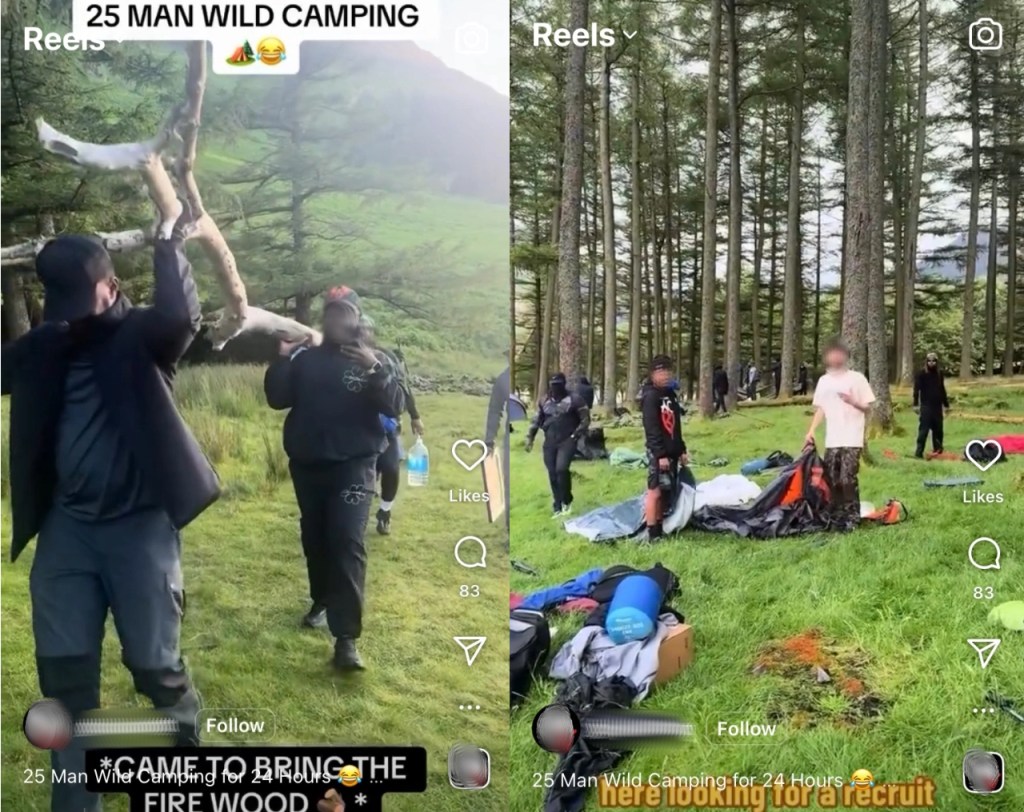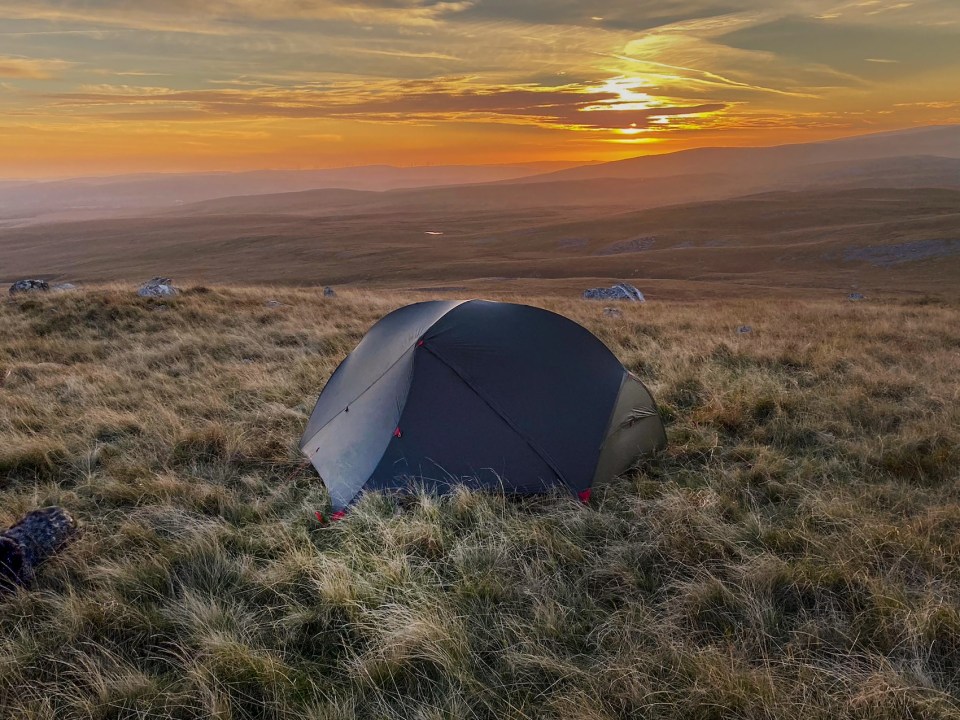All across the United Kingdom, from Dartmoor to the Dark Peak, a troubling trend is emerging: the destructive, disruptive and disrespectful activity known as fly-camping.
Often confused with the responsible pastime of ‘wild-camping’, fly-camping refers to unauthorised, irresponsible overnight stays where groups pitch large tents by roadsides or in beauty spots, bringing items such as generators, mini fridges, sound-systems and even portaloos, while leaving behind litter, fire-scars, damaged landscapes and disturbed wildlife.
Recent reports describe an ‘epidemic’ of fly-camping, with groups leaving trails of destruction, including abandoned tents, beer bottles and fire pits
Unlike traditional wild-camping, which adheres to the principles of ‘leave no trace’ – arriving late, departing early, and taking all waste afterwards – fly-camping treats protected areas like disposable festival sites.
This behaviour has surged in recent years, exacerbated by post-pandemic outdoor enthusiasm and legal rulings on access rights, leading to environmental degradation, wildlife harm, and frustration among locals and authorities.
The Covid pandemic of 2020 and 2021 sparked a boom in outdoor activities, with an 80 per cent surge in spending on UK camping trips, reaching £2.7 billion. This influx drew many first-time visitors to our national parks, but not all of them respected the rules.
At the same time, an increasingly brighter light was shone on topics like the ‘right to roam’ which in turn led to discussion in the media about how our national parks operate and to what purpose they serve.

In Dartmoor national park, a Supreme Court ruling in May 2025 restored the legal right to wild camp on private land without permission, making it the only park in England where this is allowed.
However, this brought with it a notable increase in fly-camping incidents, with park rangers reporting that many groups are ignoring the Backpack Camping Code, which limits parties to six people and requires equipment to be backpack portable. Instead, visitors arrive with carloads of gear, pitch by roadsides, and light fires in dry conditions.
Similar issues plague the Lake District, where overtourism and social media influencers have amplified the problem. A 2021 survey of 600 visitors revealed that 26 per cent admitted to littering, 52 per cent expected more bins, and 13 per cent believed someone else would clean up after them.
Recent reports describe an ‘epidemic’ of fly-camping, with groups leaving trails of destruction, including abandoned tents, beer bottles and fire pits.
The impacts of fly-camping are multifaceted. It damages fragile ecosystems and strains local communities. Litter is a primary issue, as discarded tents, food waste and equipment pollute waterways and harm wildlife.
In the Lake District, a July 2025 cleanup in Buttermere cost the National Trust £1,000 after fly campers chopped down trees and left fire scars.
Another example from June 2025 saw campers abandon a tent, mattress, and uncooked sausages at a beauty spot.
Social media exacerbates the problem, with ‘influencers’ boasting about their exploits in national parks, encouraging copycats who ignore the laws as well.
Fires pose an even greater threat. Unauthorised campfires and barbecues have contributed to a huge increase in wildfires, with 564 incidents in England and Wales since January 2025, a 717 per cent increase from the same period in 2024. Human activity, including discarded cigarettes, glass bottles, and disposable barbecues, causes most wildfires.
National parks have been hit hard: a March 2025 fire on the Peak District’s Howden Moor burned 640 acres, while another on Marsden Moor scorched 12,000 acres. In Scotland’s Galloway Forest Park, an April 2025 blaze spread, with rescuers finding an untouched camp amid the devastation, hinting at camper involvement.
These fires destroy habitats, kill wildlife, and erode soils, with long-term effects on biodiversity, already a major concern in our overloaded national parks.
Socially, fly-camping burdens locals and rangers. In the Lake District, residents report ripped-up signs, burnt trees, and portable chainsaws used to fell wood for fires. Authorities face abuse when intervening, and enforcement is limited, as fly-camping often falls under bylaws, not the criminal law, leading to few repercussions.
This has led to campsite closures, like Stonethwaite in Borrowdale, due to rowdy behaviour.
National Park authorities and organisations are responding with education and advocacy. The Lake District National Park Authority (LDNPA) has paid influencers to promote ‘Be Kind’ messages, urging responsible behaviour. In Dartmoor, rangers emphasise the distinction between wild and fly camping, promoting the ‘leave no trace’ ethos.
Campaigns push for broader reforms. The British Mountaineering Council (BMC) launched its ‘We Wild Camp’ initiative in June 2025, backed by a survey where 84 per cent of over 4,500 respondents supported a legal right to wild camp and 90 per cent favoured expanded roaming rights.
The BMC proposes creating managed wild camping zones in national parks to curb fly-camping, alongside updated countryside codes and funding for education. Similarly, the Campaign for National Parks advocates extending responsible wild camping rights via a 12-month trial in suitable areas, amending outdated laws like the 1949 National Parks Act to balance access with protection.
Councils are also acting. Westmorland and Furness is consulting on Public Space Protection Orders to tackle fly-camping, and Fire chiefs in several regions are calling to ban barbecues in vulnerable areas.
Fly-camping’s rise brings to light the underlying tension between providing public access to nature and its preservation. While organisations like the BMC and CNP argue for expanded rights to foster responsible enjoyment, the data on litter, fires, and damage demonstrates the urgent need for stricter enforcement, education and infrastructure.
Without action, Britain’s national parks, covering 10 per cent of England and vital for our biodiversity, risk becoming victims of their own popularity. Visitors must heed the call; take only pictures, leave only footprints.
This article first appeared in Northwest Nature and History.








Comments